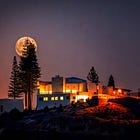Green Wednesday: Napa's Climate Career Fair & Spring Potato Planting
By Chris Benz, Environmental Contributor, and Penny Pawl, UC Master Gardener of Napa County
Support Napa Valley Features – Become a Paid Subscriber Today
If you’re reading this, you care about independent, locally owned, ad-free journalism — reporting that puts our region’s stories first, not corporate interests or clickbait.
As local newsrooms are increasingly bought by billionaires, scaled back or absorbed into media conglomerates, communities lose original reporting and are left with more syndicated content. Your support keeps quality regional journalism alive.
Join a community that values in-depth, independent reporting. Become a paid subscriber today — and if you already are, thank you. Help us grow by liking, commenting and sharing our work.
Green Wednesday: Gardening and Climate Insights
Every Wednesday Napa Valley Features brings you Green Wednesday, featuring articles from environmental voices and the UC Master Gardeners of Napa County. These contributors share research-based horticultural advice and insights on sustainability and climate topics relevant to our region.
Summary of Today’s Stories
"Climate Summit and Job Fair to Give Napa Youth a Leg Up" by Chris Benz, Environmental Contributor: This year’s Napa Climate Summit and Job Fair, happening this afternoon, March 12, at Napa Valley College, will introduce young people to career opportunities in environmental fields, featuring a keynote by sustainability leader Tyla Brown and a panel of local climate advocates.
"The Job Fair will give young people a chance to explore diverse educational, trade and career opportunities that will let them make a difference and create a more sustainable future." - Chris Benz
"Now Is the Time for Planting Spring Spuds" by Penny Pawl, UC Master Gardener of Napa County: Mid-March is the perfect time to plant potatoes in Napa Valley, and this guide explains the best varieties, growing techniques and how to ensure a successful harvest.
"Mid-March is the time to start planting. You can grow them in garden beds or in a large bucket or half wine barrel." - Penny Pawl
Climate Summit and Job Fair to Give Napa Youth a Leg Up
By Chris Benz
NAPA VALLEY, Calif. — This afternoon Napa youth will have an opportunity to get a jump on job opportunities that benefit climate and the environment. “Investing in Our Future” is the theme of the third annual Napa Climate Summit and Job Fair, taking place today, March 12, at Napa Valley College from 4 - 7 p.m. This year’s summit will focus on high school students and young adults up to age 24.
“Despite the current administration’s downplaying of the climate crisis, the world is moving ahead with climate solutions,” said Lynne Baker, co-chair of Napa Climate NOW! and a member of the summit planning committee. “The Job Fair will give young people a chance to explore diverse educational, trade and career opportunities that will let them make a difference and create a more sustainable future.”
Keynote speaker Tyla Brown is the senior partnership development manager at MCE, the event sponsor and local electricity provider serving Contra Costa, Marin, Napa and Solano counties. Her journey to a job focused on environmental justice, climate action and community engagement began during a backpacking trip in Yosemite at age 14.
“Seeing Yosemite in all its glory was life-changing,” Brown recalled. “I wanted to bring that feeling of peace back to my urban Oakland neighborhood. My friends and I started cleaning up our local park. That put me on a path of mission-driven work that supports community needs.”
A panel of local leaders, including Napa County Supervisor Joelle Gallagher and State Sen. Christopher Cabaldon, will be moderated by Liliana Karesh, a senior at Napa High School and president of Napa Schools for Climate Action. The panelists will give an update on climate actions at the local and state levels and explain how young people can take part.
The Job Fair following the presentations will have more than a dozen exhibitors offering paid internships, summer jobs, training programs or educational opportunities.
MCE has hosted more than 50 interns through its paid internship program, and Brown has supported and mentored several interns as they launch green careers. These interns have contributed in many ways, such as developing a Youth Climate Education Toolkit and participating in the launch of MCE’s “Because of Youth” social media campaign.
Mario Landeros, director of college and career readiness for the Napa Valley Unified School District, said the Job Fair aligns with the district’s strategic plan.
“We want to develop graduates who are innovative and collaborative solution thinkers,” he said. “This Job Fair can expand students’ vision about different career opportunities.”
Many jobs needed for green building, such as renewable energy projects, don’t require a college degree. Danny Bernardini, business manager for the Napa-Solano Building and Construction Trade Council, will be at the Job Fair with information about paid apprenticeships in the construction trades.
“A wind turbine project we just built for the Sacramento Municipal Utility District involved many trades,” he said. “Cement masons and ironworkers prepared the base, teamsters delivered the equipment, operating engineers put it into place, millwrights assembled the turbine and laborers helped at every stage.”
Unions are playing a role in developing new technologies for a green economy. Bernardini explained that with a union apprenticeship, trainees are paid while they learn. An apprenticeship lasts three to five years, and the union provides healthcare, retirement and job-site representation. Each year Bernardini takes about 250 students from Napa and Solano counties to visit several of the seven building trade training facilities in the local area.
“I tell kids, ‘Don’t pay them to train you. Join a union apprenticeship program,’” he said.
Brown emphasized that there is no linear path to environmental work.
“Climate work is at the intersection of many different disciplines,” she said. “That means young people can find work they authentically connect with and that connects them to their communities.”
Actions you can take:
Attend the Napa Climate Summit and Job Fair, today, March 12, 4-7 p.m. at the Napa Valley College Little Theater (Building 1200). Free parking and pizza provided.
Attend MCE’s “Because of Youth” Festival, Sunday, March 30, 10 a.m.-3 p.m. at Contra Costa Community College.
Chris Benz is a retired winemaker and co-founder of Napa Climate NOW! a local nonprofit citizens’ group advocating for smart climate solutions based on the latest climate science, part of 350 Bay Area. Info, napa.350bayarea.org.
Now Is the Time for Planting Spring Spuds
By Penny Pawl, UC Master Gardener of Napa County
NAPA VALLEY, Calif. — Potatoes are members of the deadly nightshade family. So are tomatoes, eggplant and peppers. And yet we eat them.
All of these plants are native to South America. Spanish explorers found potatoes in Peru in 1537 and introduced them to Spain. Evidence in the bones of native peoples of South America suggests that potatoes have been part of the diet for millennia.
Potatoes became very popular in Europe, but they were subject to a deadly fungal disease. The blight caused by that fungus, Phytophthora infestans, led to the Great Potato Famine of the mid-19th century in Ireland. By then, potatoes had become a staple in the Irish diet. An estimated 1 million Irish people died from hunger, and another million emigrated to other countries, including the United States.
The potatoes we plant today are not immune to Phytophthora, but scientists are working toward developing resistant varieties. That’s why it’s so important to rotate the nightshade crops in your garden, planting them in different areas each year to prevent the fungus from getting established in the soil. Some nightshade hybrids are Phytophthora resistant.
I have planted potatoes several years and enjoy eating the young spuds. Mid-March is the time to start planting. You can grow them in garden beds or in a large bucket or half wine barrel.
Because potatoes grow underground, developing on the roots of the plant, they are considered a vegetable. Tomatoes, peppers and eggplants are considered fruit because they develop from the plant’s flowers.
Potatoes are actually stem tubers. They store nutrients and energy and have all the necessary parts to make new tubers. Their blooms resemble tomato blossoms.
All nightshade leaves are poisonous, but some are more toxic than others. Don’t eat them. You should also avoid consuming green or sprouting potatoes; they contain solanine, a bitter and somewhat toxic chemical that can cause gastric distress.
Nurseries have many seedling potato varieties available now. I have had good luck planting red potatoes from the grocery store, but it’s an iffy practice because many commercial potatoes are treated with a sprouting inhibitor. You’re more likely to succeed with seed potatoes purchased from nurseries and catalogs.
As you peruse the potatoes at the nursery, look for eyes. That’s where new growth comes from. If a seed potato has multiple eyes, you can divide it before planting and make multiple plants.
I have a red potato in my kitchen now with two eyes that are swelling. I also have several tiny yellow potatoes on my counter but only one with a sprouting eye. I’ll eat the other ones as they will likely never sprout.
Potatoes like well-composted soil with good drainage. They also want at least six hours of sun a day. Frost will kill them, as I discovered on the one frosty night in my garden this year. I might try a frost-protection method I read about that involves drilling holes in the bottom of a large plastic storage container and inverting it over the plants. The holes are for venting if the air gets too warm.
A day or two before planting, cut the potatoes into sections, each with at least one eye. Leave them at room temperature to heal or form a skin on the cut surface.
Plant the pieces about 5 inches deep and 12 inches apart so plants have room to grow and develop their root system. I put a little worm compost in each planting hole before I drop the potato in. If you don’t have worm compost, plan to attend one of the Napa County Master Gardeners’ compost workshops (details below) and learn how to make compost yourself.
As the leafy green tops grow, you can mound soil around the stem. Mounding provides more room for potatoes to develop without being exposed to sunlight, which turns them green. You can start mounding when the potato stalk is about 12 inches high.
I wait until the plant blooms before harvesting, and I don’t always take all the potatoes at once. Usually I leave a few for later.
If you want to try growing potatoes but don’t have room in your garden, you can plant them in a 5-gallon bucket. Be sure to drill holes in the bottom so water can drain. Use a planting mixture of equal parts compost and garden soil. I have also seen 10-gallon ready-to-plant “potato bags” for sale, but I have never tried growing potatoes that way.
If you didn’t add worm compost, feed plants with a balanced fertilizer during the growing season. And don’t forget to water as needed.
Events
Workshop: Join UC Master Gardeners of Napa County for a workshop on “Spring and Summer Vegetables” on Sunday, March 16, from 2 to 4 p.m. at Yountville Community Center, 6516 Washington St., Yountville. Come get your hands dirty in this hands-on vegetable growing workshop. Learn what to plant now and what to plant later when the weather warms. Soil prep, irrigation, seed-starting, transplanting and potential problems: We’ll cover it all. Click here to register.
Workshop: Join UC Master Gardeners of Napa County for a workshop on “Backyard Composting” on Saturday, March 22, from 10 a.m. to noon, at Hagafen Cellars, 4160 Silverado Trail, Napa. Enrich your soil health by turning your food waste into an amendment your plants will love. Learn several composting methods you can do in your own backyard. This workshop is a collaboration with the City of Napa. Compost bins will be available for purchase at a reduced price. Registration required.
Workshop: Join UC Master Gardeners of Napa County for “Viticulture Q&A: Understanding Grape-Growing Practices” on Saturday, March 29, from 9 a.m. to noon. This home-vineyard workshop will provide an overview of three approaches: organic/sustainable; dry farming/deficit irrigation; and climate-conscious conventional viticulture. Topics include basic farming techniques, a vineyard planting checklist and management techniques for common pests. The workshop location (in Napa) will be provided in your registration confirmation email. Register here.
Help Desk: The Master Gardener Help Desk is available to answer your garden questions on Mondays and Fridays from 10 a.m. until 1 p.m. at the University of California Cooperative Extension Office, 1710 Soscol Ave., Suite 4, Napa. Or send your questions to mastergardeners@countyofnapa.org. Include your name, address, phone number and a brief description of the problem. For best results attach a photo.
Penny Pawl is a UC Master Gardener of Napa County.
—



















Very good opportunity for many people and remain in the community.